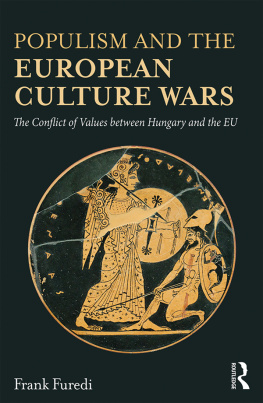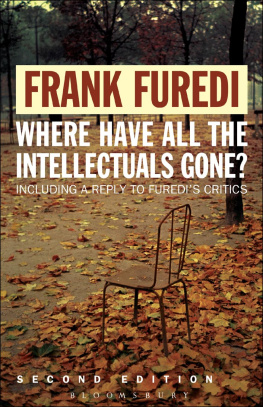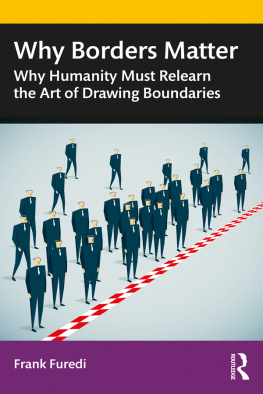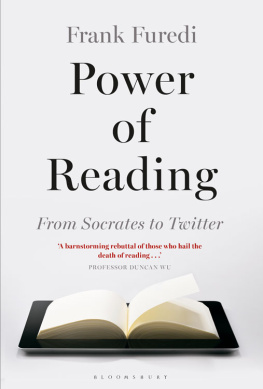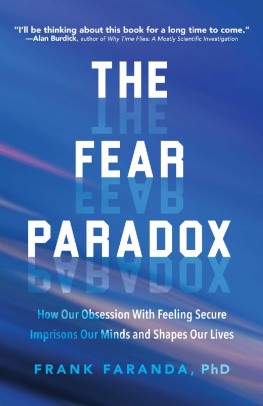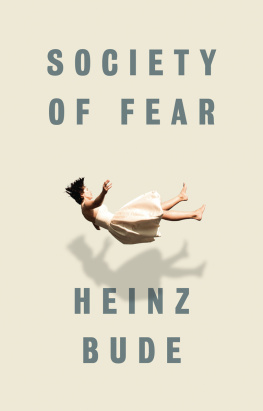Nothing in life is to be feared, it is only to be
understood. Now is the time to understand more, so
that we may fear less.
Marie Curie
When I published my book Culture of Fear in the summer of 1997, this concept was almost unknown. Two decades later, talk of a culture of fear is everywhere: from political campaigns to discussions of Islamist terrorism or avian flu. Yet there is still much confusion about the causes and consequences of the culture of fear that grips our society. This book aims to remedy that confusion. It sets the modern obsession with fear in its historical context, and examines how the way we fear now differs from the past. It analyses how our culture of fear is founded on and reinforces a fatalistic view of our humanity. And it seeks to point a possible way towards a less fearful future.
THE IDIOM OF FEAR
The term culture of fear was a relatively new concept back in the 1990s, but one that gave voice to a pre-existing and pervasive sensibility of anxiety and uncertainty. Even critics who did not accept the arguments advanced in the Culture of Fear understood that fear and culture had become closely entwined and that this development had a significant impact on public life.
At the time, the alarmist and disoriented responses to a variety of concerns the AIDS epidemic, missing children, Satanic Ritual Abuse, pollution, crime indicated that society had become fixated on promoting a climate of fear and cultivating a disposition to panic. But there was much more to come. During the years that followed, societys attention became focused on dramatic catastrophic threats such as global terrorism, global warming, flu pandemics, and weapons of mass destruction. At the same time concern about high-profile threats was more than matched by a regime of constant anxiety about more banal and ordinary risks of everyday life. Diet, lifestyle and childrearing practices, along with dozens of other normal features of life, are now scrutinized for the risk they pose to people. Fear itself has become politicized to a point where debate is rarely about whether or not we should be fearful, but about who or what we should fear.
Compared to the late twentieth century, the language we use today has become far more inclined to embrace the rhetoric of fear. At times it appears as if the narrative of fear has acquired its very own inner momentum. Since the eighteenth century there have been numerous references to an Age of Anxiety. However, in recent decades references to this condition have proliferated to the point that they have acquired everyday usage. The emergence of catchphrases such as the politics of fear, fear of crime, fear factor and fear of the future indicates that fear itself has become a singularly significant point of reference in our public conversation.
When the expression Project Fear emerged during the 2016 UK referendum on membership of the European
Of course, the question of whether society is indeed choked with fear cannot be explained with sole reference to the language that is in currency. Nevertheless language serves as an important marker of peoples attitudes and reflects the spirit of the times. More importantly, language works as a vital medium through which people voice meaning about their predicament. The growing usage of terms like the politics of fear or culture of fear indicates that a significant section of the articulate public has become concerned about the impact of fear on their lives. To gain insight into the meaning that society attaches to the term culture of fear, I explored the Nexis database of news sources to chart the evolution of the rhetoric that surrounds it and the development of its current meaning.
The first example of the use of the term culture of fear that my search revealed was a New York Times article published on 17 March 1985. The article referred to the action taken by a business executive who apparently brought discipline and planning to his organization and who has worked to snuff out a culture of fear and despair fomented by past rulers. The manner with which this early use of the term was deployed anticipated the subsequent tendency to associate it with an intangible climate of anxiety and fear. However, during the 1980s this term had only a limited currency and there were merely eight references to it in the sources available on Nexis. During this decade the term was used in reference to specific experiences such as the culture of an institution, and tended not to refer to a wider condition prevailing in society.
It was during the 1990s that the term culture of fear gradually acquired the status of a distinct, stand-alone idiom that existed independently of any specific institution or experience. In May 1990, an Australian journalist described how a series of scary newspaper stories about crime have spawned a Culture of Fear. This usage of a Culture of Fear, pointing to the crystallization of a sensibility that transcended any specific experience, marked an important point of transition in the evolution of this concept. From this point onwards the term was increasingly used in association with cultural practices and patterns that impact on society as a whole.
During the 1990s references to the term culture of fear rose from 8 to 533. By the middle of the decade, the term was sufficiently recognized Glassners text with the same title, issued in 1999, led many commentators to adopt and use this term in their reportage. Frequently, culture and fear were communicated as intertwined concepts. That the term culture of fear had acquired widespread usage was demonstrated during the first decade of the twenty-first century. In just one year, 2005, there were 576 references to the term in Nexis; a decade later, in 2015, the number of references had risen to 1,647, and by 2016, to 2,222.
Even taking into account the likelihood that Nexis has expanded the sources cited in its database, the steady expansion of allusions to the culture of fear suggests this idiom
In everyday speech, the term culture of fear carries a diffuse connotation that can encompass a variety of feelings, from unease and discomfort towards unwanted remarks and pressure to an acute sense of insecurity, powerlessness, intimidation as well as feeling threatened by crime or terror. The term culture of fear works as a rhetorical idiom rather than as a precise concept. Its meaning is often The proliferation of images such as men wearing white protection suits and gas masks, or a picture of a missing child on the noticeboard of a supermarket, offer a visual landscape for imagining and then expressing fear.
What endows both the rhetoric and the reality of the culture of fear with force is that it gives a voice to moral uncertainties and the sensibility of powerlessness in contemporary society. The frequent usage, and over-usage, of this term indicates that it increasingly serves as a metaphor for interpreting life. At times it almost appears as if fear has become a caricature of itself. The casual manner with which people express their fear of this or that act or experience indicates that it has also become a rhetorical gesture designed to draw attention to a particular point or claim.
Recent decades have witnessed the emergence of competitive scaremongering, where different groups vie with one another about what we should and should not fear. So while one group of professionals advises parents to shield their children from the sun in order to protect them from skin cancer, another group points to the risk of children suffering from vitamin D deficiency because they have been shielded from the sun. Competitive scaremongering surrounds the debate on whether vaccinating children carries more risk than letting nature run its course.


